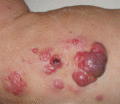
Figure 139.1
Patch‐stage Kaposi sarcoma. (a) Lesions can be subtle and typically consist of horizontally arranged, irregular vessels that dissect through collagen ...

Figure 139.5
Human herpesvirus 8 (HHV‐8) staining. Immunohistochemical staining for the latent nuclear antigen‐1 of HHV‐8 is specific for KS and demonstrates stron...

Figure 139.2
Promontory sign. This finding shows normal vessels or adnexae ensheathed within new abnormal vascular spaces.

Figure 139.6
Patch‐stage Kaposi sarcoma. Clinical lesions consist of violaceous to brown erythematous patches and plaques, most often involving the feet in classic...

Figure 139.3
Plaque‐stage Kaposi sarcoma (KS). The histological findings (a) are more exaggerated than those of patch‐stage KS, with deeper involvement, more promi...

Figure 139.7
Nodular Kaposi sarcoma. Clinical lesions consist of well‐demarcated, erythematous, firm nodules, often with accompanying lymphoedema.

Figure 139.4
Nodular Kaposi sarcoma. (a) A circumscribed tumour nodule occupies the dermis with a dense, whorled arrangement of spindled cells. (b) Erythrocyte ext...

